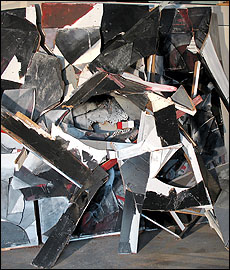Archives
Reusing urban waste to transform space
UB architect and artist creates artwork from discarded building materials
By PATRICIA DONOVAN
Contributing Editor
For the past five years, artist and architect Dennis Maher has collected discarded building materials from demolition sites and salvage yards throughout the de-industrialized city of Buffalo.

"Raven," 2005, built
with wood paneling, hollow core doors, plywood, 2x4s, tar, light
fixtures, drywall screws and house paint.
He has used them to create haunting sculptures, paintings and environmental installations that he usually installs in other city buildings slated for demolition, restoration or renovation.
Maher is an adjunct instructor in the School of Architecture and Planning, so his use of buildings—and their torn and damaged parts—stems from a long-standing fascination with the origin and nature of urban structures, and the materials lend themselves to Maher’s metaphoric intent.
His art speaks to the way in which these construction materials and the buildings that comprised them once were used. It questions how he and others are “reusing” both. It also asks what this transformation means to the future of an urban space whose old parts stand before us like tangled, complicated ghosts of our industrial lives.
“Eternal Returns,” Maher’s “reorganized remains of postindustrial urban transformation,” was exhibited earlier this week at Cornell University’s John Hartell Gallery.
“On one level, my works offer an approach to reinvigorating vacant buildings through the reusing of urban waste,” he says, “but on another, perhaps more abstract level, I want the resulting constructions to suggest, in their layered and textured surfaces, the contours of cities and landscapes that have yet to emerge.”
Maher notes that in our postindustrial urban environment, we live in the midst of waste and emptiness marked by buildings, often huge and industrial, now considered ruined or useless.
He points out that the demolition, renovation and restoration of these buildings produce a great deal of vacant space and an enormous amount of urban waste.
“We see it,” he says, “in the spaces vacated by their demolition, inside the ‘leftover’ buildings themselves when stripped of their former function and the materials that defined them, and in the enormous piles of plaster, wood and metal that constituted their structures.”
Maher calls his structures “afterlives” and says they are his attempt “to renew and give another life to the wasted remains of a city.”
In searching for materials and producing his work, Maher says he explores the latent potential of waste and emptiness, while at the same time cultivating new relationships between demolition contractors, property owners, developers and the material waste of buildings itself.
For more information on his work, contact Maher at 906-1434 or dmmaher@buffalo.edu.
